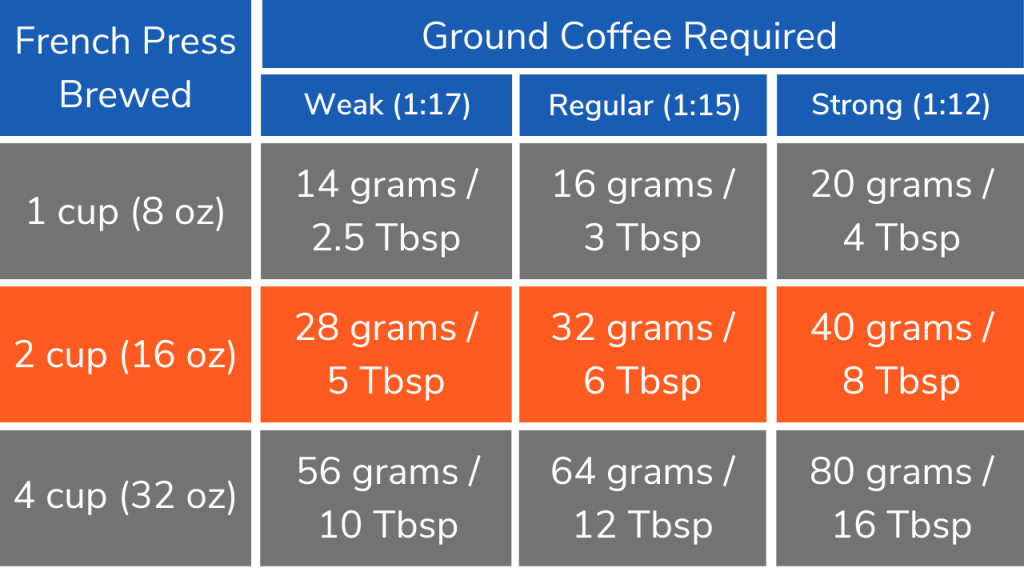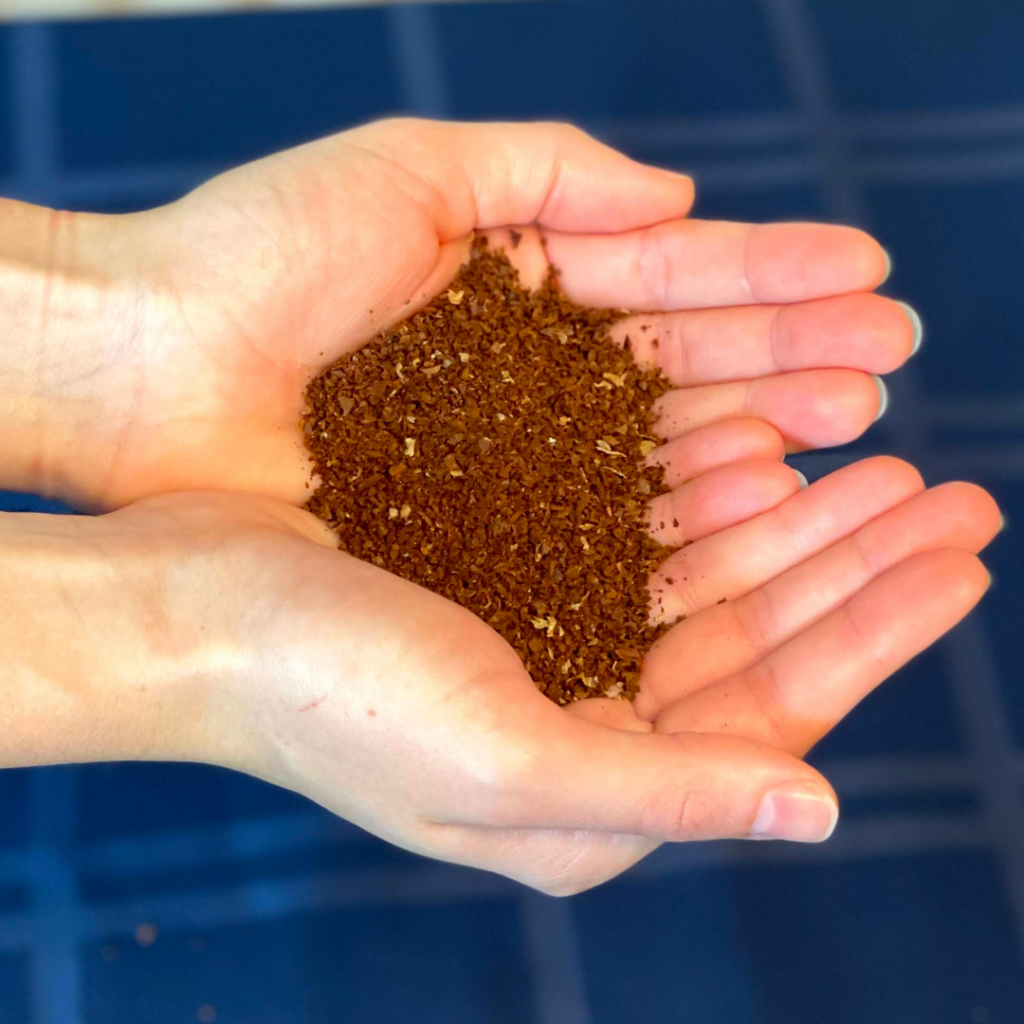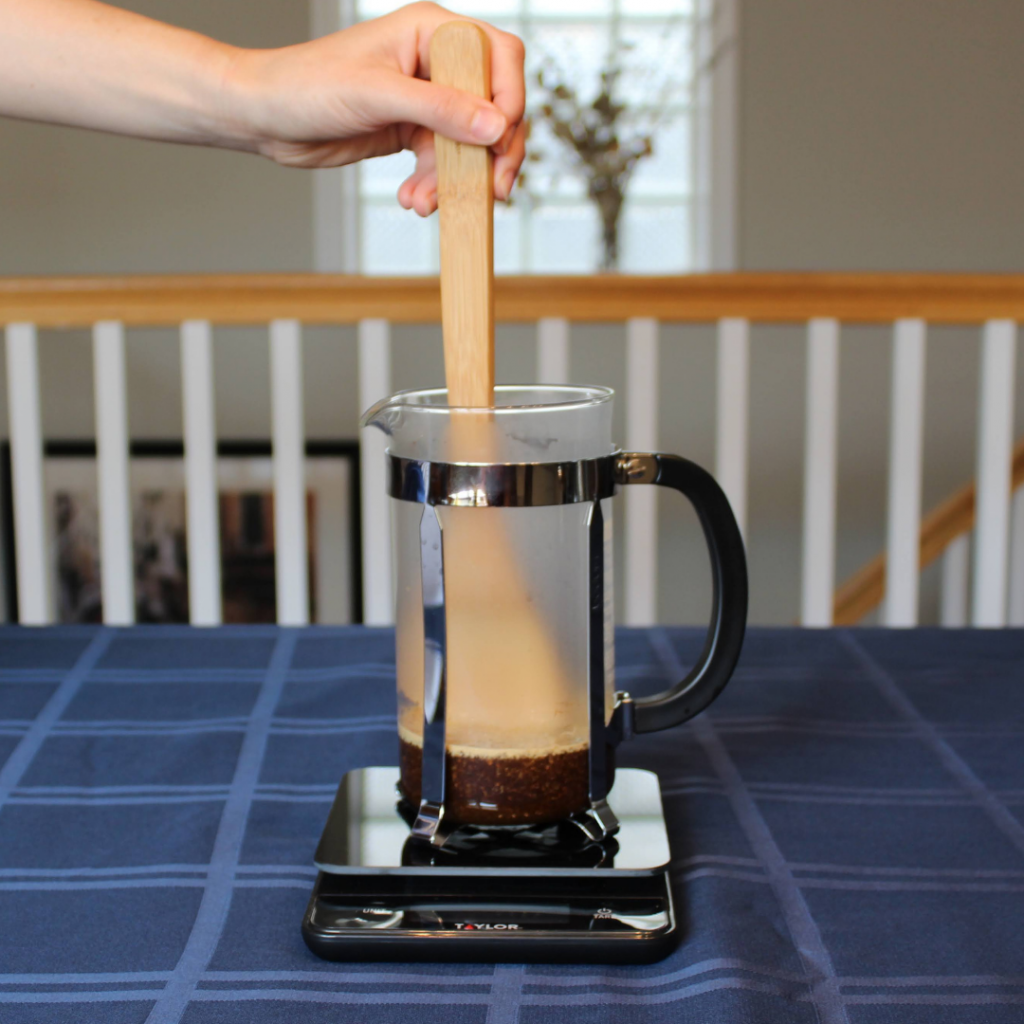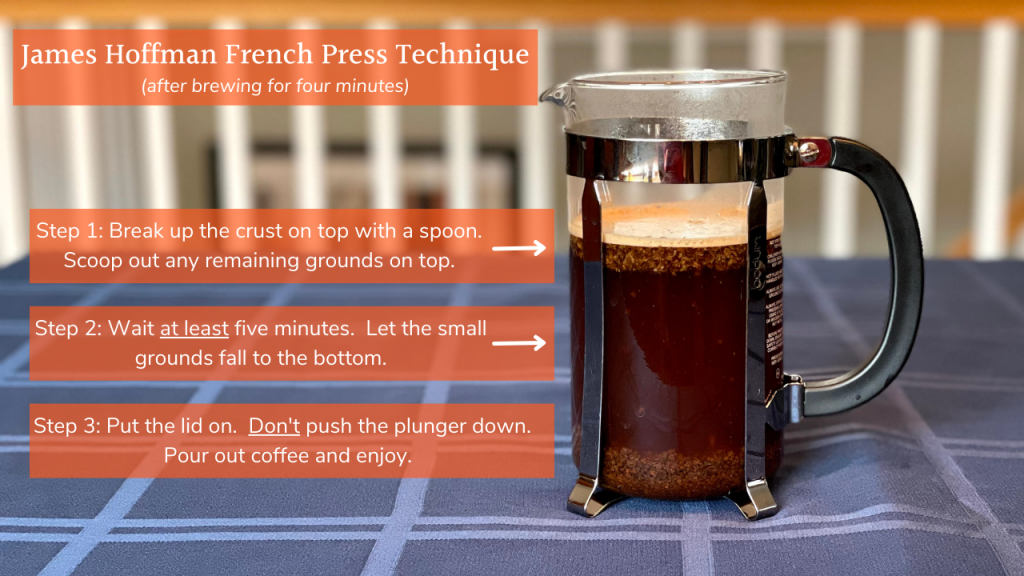The French press brews excellent coffee with rich flavor. It’s a simple process, but requires the right French press coffee ratio, grind size, and brew time for the best taste.
I’ve been making French press coffee for over a decade and have brewed a thousand batches. To get the perfect French press coffee, you’ll need to measure the right amount of coffee (1:15 ratio), get a coarse grind size with a burr grinder, and brew for four minutes.
I’ll go through a complete recipe with tips for full-bodied flavor without leftover coffee grounds. Let’s start with the most important part: measuring the right amount of coffee for a French press.
The French Press Coffee-to-Water Ratio
I recommend using a French Press coffee-to-water ratio of 1:15. The French Press coffee ratio can range from 1:12 for a strong cup of coffee to a 1:17 ratio for a weaker cup. These ratios are based on weight and are best measured in grams.
In standard kitchen measurements, a large mug of coffee (16 oz of water) requires 6 Tbsp of ground coffee for a 1:15 ratio, 8 Tbsp for a strong 1:12 ratio, and 5 Tbsp for a weak 1:17 ratio. Most French presses are 32 oz, which means 12 Tbsp of ground coffee at regular strength. Here is a table showing the coffee needed for different sizes and strengths.

I strongly recommend using a scale to measure water and coffee for a French press. A scale will measure coffee far more accurately than tablespoons, measuring cups, and (worst of all) scoops. I recommend this scale, which is accurate, inexpensive, and includes a timer. A scale comes in handy later.
You can also use our calculator to find how much coffee you need. Input your brewing volume (in fluid ounces) and the coffee-to-water ratio (just the water ratio) to find the necessary ground coffee:
Lean towards using more coffee than expected with a French press (our graphic rounds up a little). The French press is an immersion device where water is constantly saturated with coffee, which means it takes longer to fully extract coffee from the bean (this article geeks out on the science). The French press uses a higher coffee ratio than pour over devices and more coffee than the “golden ratio” of 1:18 coffee-to-water. This means less water in our ratio, so use a 1:15 or 1:12 ratio of coffee-to-water for a French press. Anything above 1:17 will have a weak taste, like water.
Brewing French Press Coffee
I have a French press recipe that is similar to most other techniques out there. The nice thing about this brewing method is it’s pretty simple and quite forgiving. You can also watch our video, which walks through the recipe with five tips for making better coffee.
Step 1: heat water
Heat water to 200 degrees. Avoid using boiling water, which will over-extract coffee and lead to a bitter flavor. If you do boil water, let the hot water cool off for one minute to reach 200 degrees. A range of 195 to 205 degrees is perfectly fine.

Step 2: grind coffee
Use a burr grinder to grind the coffee beans as the water heats up. The grind size should be coarse ground coffee for a French press. The coffee should have the look and texture of sea salt.
A lot of places suggest a very coarse grind for coffee beans, but don’t overdo it. I think a regular coarse grind is better, like coffee that is more coarse than typical pre-gound coffee. A finer grind size will lead to richer-tasting French press coffee in your cup.

Step 3: bloom coffee
Add the ground coffee to the French press and pour in enough hot water to submerge the grounds. Add water that’s about twice the weight of the total ground coffee. Give the coffee a gentle stir so that all the grounds are saturated. Only stir the French press this one time!
Let the coffee grounds sit for 30 seconds. This stage is the coffee bloom. Coffee releases carbon dioxide during the bloom, which leads to better coffee extraction.
Stir with a wooden spoon to avoid cracking the French press. Remember, it is made of glass and filled with hot water, so it’s sensitive to any taps from a metal spoon. That said, I’ve stirred a French press with a metal spoon many times without issue (but I’ve cracked a French press in other ways!).

Step 4: add remaining water, stir once, and wait
Add the remaining coffee, and stir once. Then cover the coffee and wait. A French press takes four minutes to brew. Use a timer (or your phone) to be precise. The brew time can extend to five minutes depending on the temperature of your water, whereas cooler water will take longer.

You don’t need to do anything else during this time. I’ve experimented with a midway stir, but it led to a muddy flavor. One stir is enough to saturate all the grounds and brew the coffee fully. Just patiently wait those four minutes.
Step 5: plunge and pour
Place the lid on the French press and gently push the plunger down to strain the grounds. The keyword here is gently.
Don’t rush because the plunger agitates the coffee grounds, which can end up in your cup. These grounds make bitter coffee, which you’ll notice at the end of the cup. The sludge of grounds at the bottom of the cup is the bane of a French press.
Stop plunging before reaching the grounds; don’t press the plunger to the very bottom! A slow plunge and gentle pour will reduce grounds and improve flavor.

Brewing French Press with the James Hoffman Method
James Hoffman is a coffee extraordinaire, and his French press coffee method is widely revered. It brews a cleaner cup of coffee for those with extra time in the morning. The Hoffman French press method is worth learning if you don’t like the grounds that come in French press coffee.
This method follows the same process above until it’s time to plunge the French press coffee maker (Step 4). Once there, stir the coffee slightly once it has brewed for four minutes. This breaks the crust of grounds on top, and most coffee will fall to the bottom. Remove any remaining grounds floating on top with two spoons.
Put the lid on and wait for 5-7 minutes. The extra stir and wait is the main difference in the James Hoffman French press method. The small coffee grounds settle at the bottom of the press during the several-minute wait.
After 5-7 minutes, pour out the coffee without pressing the plunger. The coffee grounds have already settled, so the plunger will only agitate them from the bottom. Leave the plunger at the top of the coffee to strain any floating grounds. There will be far fewer grounds in the cup because of the extra time to settle.

The James Hoffman French press method brews coffee with a clean taste, even at the end of the cup, while a typical French press coffee will have grounds. It’s good for those who don’t like the heavy, bitter mouthfeel (yet still like a rich and robust French press coffee) and have an extra 5-7 minutes in the morning!
You can see the full James Hoffman French press recipe here.
Want more ways to brew coffee?
If you’re ready for a slightly more advanced coffee lesson, try learning pour over coffee. You’ll get a cleaner flavor (like the JH recipe), and pour over is ideal for light roast coffee with floral notes. You can also check out our other brewing guides.




